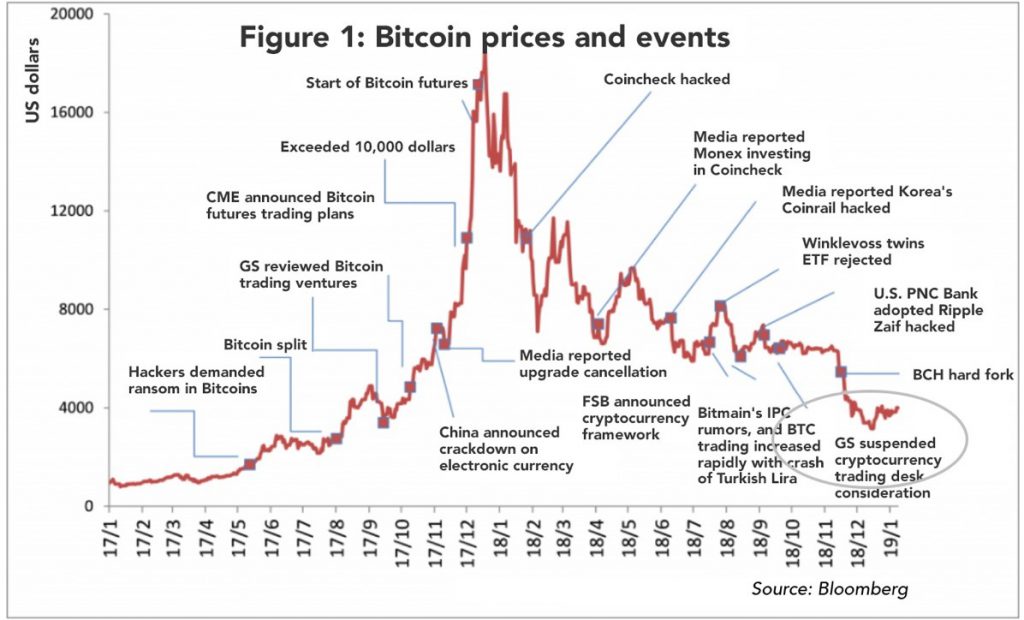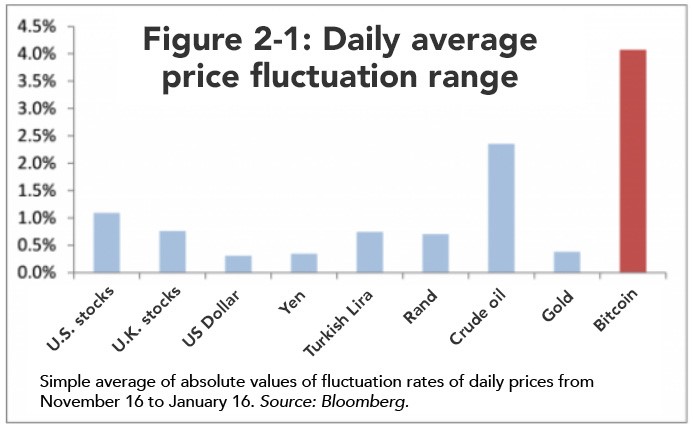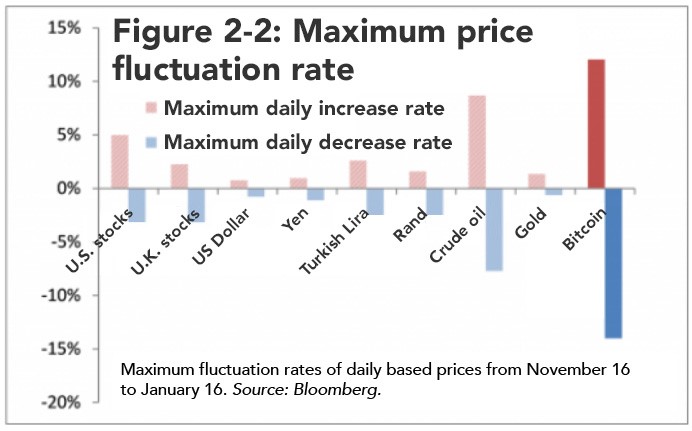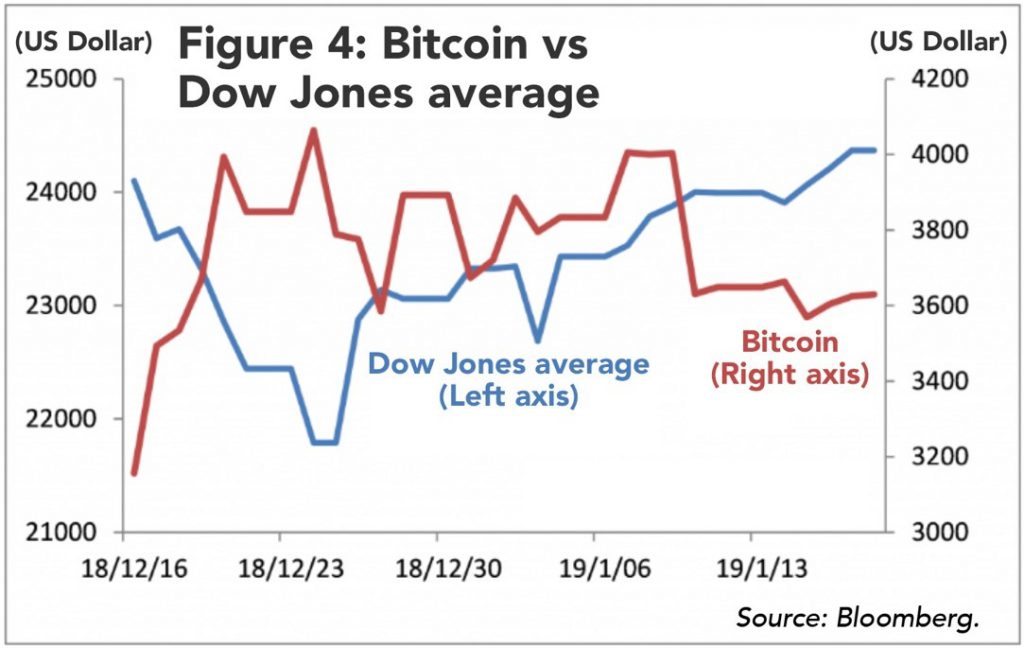- Although cryptocurrency markets appear to have calmed down, fluctuations are still the largest among major financial markets. The average daily movement in the last two months has been 4.1 percent.
- Catalysts include regulations, system problems, stock market trends and an increase in participants and products. The market reacted the most to stock market trends, followed by system problems such as the hard fork.
- Although cryptocurrency also fell as expected in mid-December when the U.S. stock market was hit by a panicked selling, there later emerged a reverse correlation where Bitcoin (BTC) was bought when U.S. equities or the U.S. dollar fell. On the other hand, the cryptocurrency market no longer reacted as much to news such as regulation reinforcement or any increase/decrease in market participants.
- The current movement strongly resembles the first cryptocurrency boom and crash in 2013. At that time, prices fell 80 percent from their highs and then took a year and a half to revive. For the time being, the focus will be on monetary easing and the U.S. stock market trends, the start of BTC futures trading by the U.S. cryptocurrency exchange Bakkt, approval of the cryptocurrency ETF in the U.S. and progress of various tokenizations.
One Year after the Boom, it Seems the Market Has Stopped Moving
One year from the boom at the end of 2017, the cryptocurrency market cap is $123 billion. That’s about 80 percent below its December 2017 peak. In particular, it seems that movements have completely stopped in the two months since the drop due to Bitcoin Cash’s (BCH) hard fork (change in specifications) in mid-November (Figure 1).

However, this is because the previous range was simply to wide. Even today, cryptocurrency is still the most volatile asset, compared with other financial assets. The number of coin types has increased by more than 50 percent in one year. There are currently 2,111 types and the number continues to grow (CoinMarketCap).
The average daily fluctuation rate over the past two months is 4.1 percent, greatly exceeding even the Turkish Lira (Figure 2-1). Moreover, movement is not only in the downward direction. The maximum rate of increase was 12 percent, a similar figure to the decline of 14 percent (Figure 2-2). This rise was due to positive factors such as the release of blockchain-related products by Amazon.com (AMZN) and BCH’s hard-fork problem convergence. Moreover, in December, following the U.S. stock market selloff, there were days when cryptocurrency prices rose 5-10 percent.


Equity Swings Were the Biggest Factor Impacting the Crypto Market
Currently, what are the factors influencing the cryptocurrency market? The days of great cryptocurrency price movements were extracted, and based on the daily news flow, factors were classified as follows: regulations, system problems, stock-market trends, market participants and product increase/decrease. As seen in Figure 3, the price fluctuation range compared to the previous day for each factor was totaled (absolute value, namely, the scale of decline was also totaled as a positive number). The results show that the market responded most to the stock-market trends.

At the beginning of December, there were days when cryptocurrency declined along with stocks in a panicky risk-off mood. However, in the past one month, movements to buy cryptocurrency were conspicuous when the Dow Jones Industrial Average fell (Figure 4).

Following stock market trends, the next kind of factor moving the cryptocurrency market was system problems. Especially around this time, the BCH issue mentioned earlier and large-scale updates of Ethereum (ETH) were major factors. However, the market hardly responded to small-scale challenges such as the recent 51 percent attack on Ethereum Classic (ETC), reported by media on January 7, and the hacking of the New Zealand exchange, reported on January 16.
Regulatory news had an additional impact. For instance, BTC rose 4.5 percent when the media reported that the FSA may consider a cryptocurrency ETF on January 7. This report later proved incorrect, pushing down prices by 5.6 percent.
There was a mixed reaction to new participants and products entering the market. Some investors reacted positively to news of a booming ETH-based blockchain game. But the market remained more or less unresponsive to negative news like the contraction of China’s BTC mining giant Bitmain. This was expected to a certain extent.
What are the price catalysts now?
With prices falling this far, it is not easy to become bullish. Still, one ray of hope is the crash and revival seen after the first cryptocurrency boom before the Mt. Gox incident in 2013. As shown in Figure 5, the current cryptocurrency movement resembles the decline after the first big rally. At that time, BTC revived dramatically after sliding 80 percent from its high, and enduring a 1-1/2 year slump.

For the time being, the focus will be on the financial policies and stock market movements in the U.S. Even if the U.S. Federal Reserve stops interest-rate hikes earlier. A weak U.S. stock market could also draw money back to cryptocurrencies.
In addition, the market could see more participants and attention when Bakkt’s BTC futures begin trading. The prospect of a cryptocurrency-related ETF is another catalyst to watch. We also need to keep an eye on the trend toward tokenization. It’s become popular to sell real estate and unlisted stock in small lots via tokens. If these markets become active, cryptocurrency investors will increase and practical uses will become more clear.
Depending on how these trends play out, the revival of the cryptocurrency market is not just a dream.





























